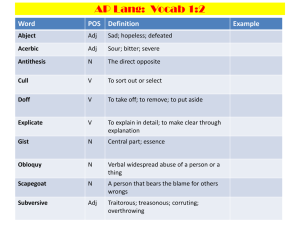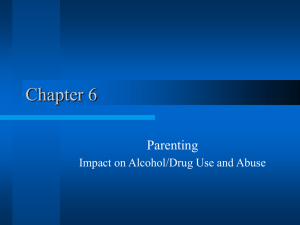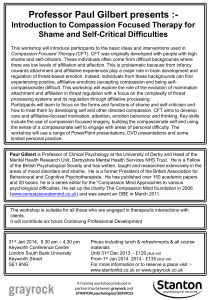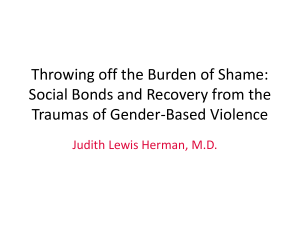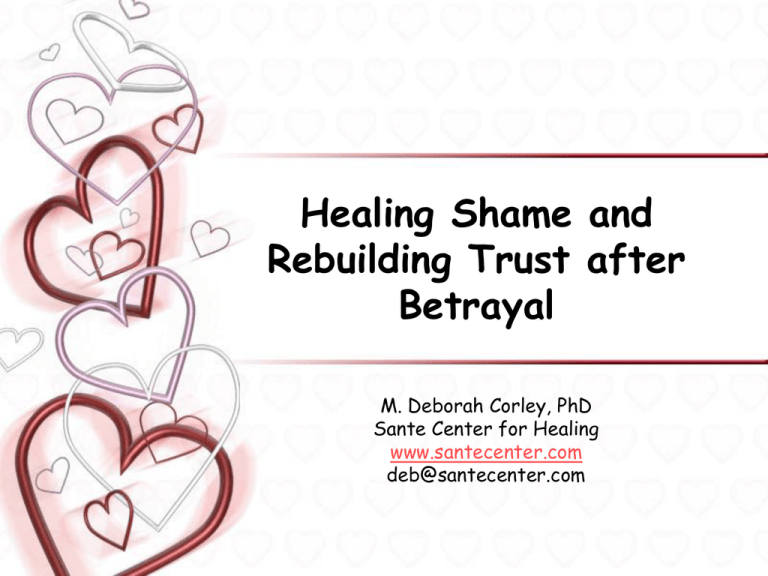
Healing Shame and
Rebuilding Trust after
Betrayal
M. Deborah Corley, PhD
Sante Center for Healing
www.santecenter.com
deb@santecenter.com
Conference Objectives
Disorders that impact physicians connected to
shame & betrayal. Repeated dishonesty = betrayal
Sexual Misconduct/Hypersexual DO/Sex addiction
Sex with patient/subordinate
Other behavior that is against corporate policy or law
Other addictions
Other co-occurring disorders that create disruption
PHP helps rebuilding relationships
PHP as monitor, advocate, educator
Can be another place HCP form support groups
Promoting educational events in collaboration with
other to assist couple, family, work
Workshop Objectives
Betrayal & Trust
Impact of attachment
Shame and healing from shame
Rebuilding relationships after betrayal
Everyone being monitored learn more about handling
conflict and attunement (attachment style, selfregulation versus dyad/group regulation)
Spouse/family – process should have started at
treatment; understanding and supporting the process
Place to discuss the shame; place to acknowledge frustration
Practicing being better friends with self and others
Workplace amends and relationship mending
What is betrayal
Perceived violation by a partner of an implicit or
explicit relationship relevant norm…when the
victim believes that the perpetrator has
knowingly departed from the norms that are
assumed to govern the relationship, thereby
causing harm to the victim.
Betrayal is the intentional or unintentional
breach of trust.
Finkel, et al. (2002)
What is trust?
Define trust as a belief or
expectation of reliability or
dependability of another.
In specific interactions we can rely
on our caretaker - then partner to
behave in such a way that our own
payoffs are maximized.
Trust & safety are pillars of
attachment theory.
How do we evaluate trustworthiness
Honesty – leads no secret life and does not lie
to you or others
Ethics/values –has ethical standards and values
that you agree with and behaviors are
consistent with the ethics/values
Accountability – does what he/she says and you
can see proof of it
Alliance – has affinity with you, has set
appropriate boundaries with others
Resolution – ongoing processing of shame
Transparent – is forthcoming
Gottman, 2011
Impact of attachment styles
Early interaction with Mom (caretakers),
genes, other life experiences format the
brain
Contributes to how we learn to manage or
mismanage emotions
Auto-regulate
Dyadic or interactive regulation
We are only as good at emotional (arousal)
regulation as were our best caregivers
Addicts have insecure attachment styles
and utilize maladaptive strategies to
manage emotions
Avoidant/dismissing insecure attachment
Dismissing: Feels worthy of love with negative
disposition towards others. Under trusts.
Learned how to be strong, self sufficient, best is never
enough; chronic need for alone time
Report can’t feel/doesn’t know how feels; denies shame.
To cope, auto-regulate to shut down or over-regulate the
system; use work to distract from emotions;
Push others away to avoid rejection, vulnerability
Devaluing: finds fault in all others – always the expert
Idealizing: had to falsely idealize parent to meet their
needs, so will repeat pattern with you, or group leader
Control: selective attention/inattention ; anger to
rage; shaming criticism to control others
Anxious insecure attachment styles
Anxious/Ambivalent/Angry-resistant: Feels
unworthy, too willing to please, fearful of
asserting true-self. Over trusts.
Overwhelmed by own feelings; hyper-vigilant about
distancing from others; fear abandonment –
continuously scan for internal and external cues to
amply the distress then feel burdened by it
Feel lonely, seek out the untrustworthy
Trouble relying on others because filled w/self-doubt
but still long to attach (put self in harm’s way)
High functioning but often are enabling/over
functioning in relationships or on-the-job (or in group);
are seeking approval of others to verify they are
worthy; get angry/resentful if don’t get attention
What is Shame
Shame is not the same as nor simply the
product of negative self-appraisals
Innate affect designed to help us
We learn early it is one way to control
others without killing them
Shame carries the greatest potential to
damage the sense of self and is potentially
the most important emotion to examine for
addicts and their partners.
Toxic or magnified shame progressively
captures and dominates the self
Shame keeps the addict and partner bound
pain; it seems to be associated with every
schema used to inform their behaviors
Nathanson, 1992; Wallin, 2007; Kaufman, 2010
Addicts are not trustworthy
Chronic liars
Break rules
Blame others; cannot be counted on
Operate out of self-interest; live a
secret life
Even when caught do not disclose the
whole truth
Betray those they fear most will
abandon them
Betrayal = Relational Trauma
Because the betrayal is just like an
attachment injury, partner is stuck
in anger, fear and distress. Often
has own shame and takes on addict’s.
Depending on partner’s attachment
style and skills in tolerating
emotional distress, she/he can
become so flooded with emotion
cannot process the trauma or
regulate emotional state.
Flooding – 3 parts
Discovery happens
Stage 1 – Danger is present! Feel shock.
Stage 2 – Signals the need to fight, flee, or
freeze. Stress response system gets in gear,
stress hormones amp up heart rate and blood
pressure (once pulse is over 90 can’t make
sense or easily calm down) so explode in anger
and/or tears
Stage 3 – system is overwhelmed, shut down
emotionally, extent of betrayal sets in
Next film clip – sexual betrayal is hardest.
Look for the 3 parts of flooding.
Betrayal is proof of breach of trust
When someone has crossed a
sexual boundary, the betrayal is
experienced as a relational trauma
and takes significant time to
repair.
Betrayal isn’t a balanced process;
partner no longer knows who the
addict is.
Restoring Trust After Betrayal
This first stage is long and very painful. 1 – 3 yrs
Addict has to atone; power shifts to partner
After disclosure couple agrees to trial period –
agrees to transparency, verification, not rock the boat
When partner is triggered, addict always
expresses genuine remorse
“I am sorry that reminds you of my past behavior &
brings you so much pain.”
Agree not to use Four Horsemen when triggered
Adapted from Gottman, 2011
Four Horsemen of the Apocalypse 1
Criticism
A verbal, global description of a flaw in
your partner’s personality. Women whose
complaints have long been ignored complaint escalates to criticism
Defensiveness
Countering to protect oneself or defend
one’s position or actions. Shame can trigger
defensiveness
Four Horsemen of the Apocalypse 2
Contempt
Any critical statement you make when you
feel superior to your partner, to put
him/her down or shame him/her
Stonewalling
The listener withdraws from the
interaction while staying in the room. Men
exceed women in this area
Adaptive Responses
Self management moves from automatic,
inflexible non-conscious level of acting out
to purposeful, flexible, conscious system of
self-regulation.
Important to agree to calling time-out for self
repair if become flooded
Developmentally move toward complexity –
self play to interactive play; auto-regulation
to interactive mutual regulation.
Addict learns to attune, then leads partner
in first stage of attunement.
ATTUNE – Addict leads Dyadic regulation
Awareness of emotion - (CYA) exhale, apologize
Turning towards the emotions “I hear that this
brings up your fear again – what else do you feel
and what do you need right now to help?”
Tolerance of the emotional experience (two valid
perceptions of the event, but…)
Understanding the emotion -- seek to understand
connection between past and present. “Does this
remind you of other times in your life or with me
that are making it feel worse?”
Non-defensive listening to impact of the emotion
Empathy (it makes sense to me that you would
feel this way)
Restoring Trust After Betrayal 2
Addict listens repeated expressions of partner’s
feeling without defensiveness - ATTUNE
Over time, explore what led to shame, acting out
(and acting in) and turning away from each other
ID patterns common to attachment style that are
unique to couple history that contribute
Explore how being untrustworthy contributed to shame
and excuse to use/moving away
Goals for change; commitment by both for ways to
change & maximize cooperation
If partner can’t commit – what does it take, restitution
How much is still about shame?
Restoring Trust After Betrayal 3
Set up high costs of subsequent betrayals
(what happens if addict relapses)
Addict establish sense of responsibility for
partner’s welfare (what would it look like, sound
like, feel like) (Savings account for taking care of
partner).
Role of polygraph and drug testing.
What would consequences of relapse be?
What’s a deal breaker (now – in 5 or 10
years?)
If partner can’t commit – what does it take,
what is restitution?
How much is still about shame?
Antidotes for Shame
Develop self-compassion and capacity for regret
Shame is internal form of punishment, a walk-up
call from the smart part of your brain, self
punishing is only a temporary suppressor of the
behavior. Talk about shame.
Practice recovery. Responsibility, accountability,
seek guidance, +/- inventory, amends, give back.
Self-empathy leads to empathy for others.
Discuss ways for regaining equal power in other
relationships
Antidotes for Shame
Develop strategies for dealing with critical
or shaming people (especially those in your
head) (Practice dialogue/boundary setting)
Become consistently authentic – accept
and integrate all parts of self; resist the
need to be dependent on external praise
or prove your point
Be clear about values and base mindful
choices on recovery values; practice
humility
Grieve the past circumstance that
contributed to the shame. Identify the
lessons and practice forgiveness.
Restoring Trust After Betrayal 3
Why partner/addict did not leave? (especially if
partner is stuck)
Reversing Betrayal Processes
Learning constructive conflict and self-disclosure
versus conflict avoidance or escalation
Couple agrees to principle of mutually meeting each
other’s needs (We have each other’s back.)
Agree to turn towards bids for attachment; increase
appreciation & respect (clarify boundaries/triggers)
Ritual of checking in emotionally – processing shame
when it comes up
Cherish versus trash; be a safe haven
Establish norms; create the sacred in relationships
Regular conflict in relationships
Happens in all relationships!
To totally avoid issues is dangerous to create
resentment and self-loathing (why can’t I say my
truth?)
Over responding with negativity and high levels of
anger leads to flooding (B/P increases and heart rate
exceeds 90 BPM) the opens door for Four Horsemen
No resolution means no repair then distancing,
loneliness, parallel lives, more resentment, easier
entry to anger
Anger leads to “nasty-nasty” interactions, opening up
childhood disappointments and vulnerabilities
Leads to an excuse to use and be untrustworthy
Conflict
Effective repair
Soft-startup (Neutral, Nice)
Positive sentiment – give benefit of
doubt, overrides negative
Path to attuning with your partner
Soothing is the antidote to flooding
Or make it worse
Running on emotional empty
Nasty-nasty
Four Horsemen
Attuning exercise for couple
State of the Union Weekly Meeting – 1 hour
ID 5 appreciations for positive things person
has done this week (5:1 rule)
ID 1 negative thing want to bring up & how
relates to shame
Remember to postpone persuasion until satisfactorily
state the partner’s position (summarize, validate
feelings, and need)
Speaker use constraint = gentle start up, when get to
request say what partner can do to solve it that would
work “I feel this, I need this.”
Listener can take notes but keep eye contact, don’t
focus on facts, but on speaker’s pain
Workplace Repairs
Re-entry processing when breach of trust
impacted people in workplace
Appropriate disclosure
Give staff chance to observe & acknowledge what
happened from their perspective
Allow feelings to surface
Get & give support
Reframe experience from crisis to opportunity
Take responsibility
Forgive yourself (and others)
Let go, Move on.
Workplace Repairs Exercise
Activity -- observe & acknowledge
Describe situation on text when trust breaking
behaviors spilled over into the workplace
Describe behaviors say and are fearful will reoccur
Express how they and the work environment were
impacted
HCP repeats what he/she hears, take responsibility
Establish new policies where appropriate
Earning a secure attachment
Find a few “good enough mothers” (GEMs)
to practice dyadic regulation (often early
in recovery, one primary “good enough
mother” is the therapist, friend in
treatment/therapy) GEMS help relearn
how to attach and practice regulating
emotions in a healthy way
Other places to find GEMS
Mutual Help/12-step groups/sponsor
Therapists
Continuing therapy groups
PHP
Characteristics of Intimate Conversation
Identify in words what feeling
Asking open ended questions
Using statements that follow-up on
answers to OE questions for deeper
understanding of partners thoughts and
feelings
Using statements of compassion &
empathy to express understanding
Strategies for repair after the horse
Handouts
Gottman Antidotes for Four Horsemen
Gottman’s Stop Action
Go to safe place – do self repair
Do resolving relationship problem worksheet
Then ask for time for “container” (can call it
what ever you like)
Take responsibility for his/her part
Make plan together for how can handle
differently in future
Practice, practice, practice
Attuning after regrettable incidents
CYA (calm you amygdala) – long, slow exhale
Feeling – each person takes turns describing
how felt during incident
Realities – each person describes his/her
reality during the incident – what happened
Accepting responsibility for what might have
set up his/her to become hurt, respond
defensively, withdraw or escalate the fight
What triggers reflected enduring childhood
vulnerabilities
How triggers are associated with past
What person can do to make it better next
time; to make it better today
Maladaptive Strategies to Cope w/
Shame
Withdrawal (Anxious; Disorganized)
Aware of shaming event as negative and accept
the shaming message as true; want to minimize
exposure to shame so withdraw from attachment
opportunities
Disappear from social or intimate situations
Passivity, underachievement
Attachment style does not allow for seeking
support or advice to help deal with the negative
emotional state
Become more isolated and depressed (then have
to “use” to cope with the depression and shame)
Maladaptive Strategies to Cope w/
Shame
“Do unto yourself what you fear others may do to you!”
Attack Self (Anxious; Disorganized)
Self-talk about event is critical, FSLA
experiences anger and contempt toward self
Externalize self-criticism
“Nobody likes me, every body hates me, I deserve this bad thing.”
Often results in reassuring comments by others
but it is never enough
Thus pushing others away, FLSA experiences more
shame, reinforcing belief “I am flawed”
Identifying with the perpetrator/domestic
violence
Maladaptive Strategies to Cope w/
Shame
Attack Other (Avoidant; Disorganized)
Use arrogance, demeaning, anger and blaming in
attempt to project shame onto others to lessen
emotional pain associated with negative message of
shaming event
Use aggression, out-of-control raging, physical
abuse, and critical verbal assaults used to take
focus off self
Carrying a grudge or staying stuck in resentment
for past transgressions giving self permission to
engage in behaviors that would otherwise cause
shame; carrying grudge
Justify actions with righteous sense of anger
Shame – Adaptive Strategies
Secure attachment use it to pay
attention to opportunity to use
both auto-regulation and
interactive regulation
Ground self – feel floor or chair,
focus on breath in attempt to
regulate
Self talk is about need to pay
attention to behavior
Talk responsibility for behavior;
attempt to attune with other person
Strategies for TX Shame
Increase emotional competence skills;
Identify where use adaptive and maladaptive
behaviors
ID where feel/experience/project shame (or cooccurring emotions/i.e. confusion, fear) in past and
present
Safe place imagery & internalized coaches,
resources (protective adult self, nurturing adult
self, spiritual guide)
Reprocess and reframe shame events
Repair attachment injuries associated with shame
(EMDR, somatic/body work, art, brain spotting)
Meeting developmental needs (basic safety,
existence/valued as a child, enmeshment, dismissed)
Reframe events of life story or time line
Strategies for TX Shame
Define what earned secure attachment is
Defining what earned secure attachment is
Secure: Feels worthy plus has expectation that
others are generally accepting and responsive
Healing work in safe environment (relationships
with therapist, group, sponsor, spiritual advisor)
Who is safe to do work with? How do you know?
Body work, “I feel, I need” conversations,
Repair when disconnection happens (what innerchild needs/needed)
Practice skill work within therapy, group, friends
Re-engage with Authentic Self
Be Trustworthy at all times
The Sound Recovering Relationship House
Creating
Shared Meaning and
Rituals of Connection
Honoring One Another’s Journey
Better Resolution of Conflict
Talking differently about perpetual problems
Effective conflict resolution for solvable problems
Adopting a Positive Perspective / Shared Goals
Turning Toward Versus Turning Away
Increasing Emotional Bank Account
Fondness and Admiration
Becoming Best Friends
Learning to Attune/Use Interactive Regulation Skills
Creating Sound Foundation of Recovery
Healing Sexual Shame
Keep identifying the shame and talking about it
Cultural norms and family rules, trauma impact
The partner’s feelings of betrayal and fear of not being good
enough; impact of shame – keeping her bound to pain
Create more equity between partners
Saying no to sex – Sexual abstinence contracting
Sexual moratoriums
Replace having sex with learning about attachment & intimacy
Learn more about own and partner sexual desire (Katehakis,
Erotic Intelligence, pg 57)
Exploring history of abuse, lovemap crosswiring & arousal
damage, and impact of shame on sexuality
Beginning to explore sexual behavior again
Sacred space and time (Spiritual connections)
Keep talking (both shame and celebration)
Returning to Sex After Betrayal
Have to have done the other work before
returning to sex
Create personal sex and intimate trust
Knowledge of each other’s personal preferences
in sex, love, romance
Reversing processes of impersonal or
maintenance sex (objectifying, dissociation due
to shame). Don’t have sex if in shame or haven’t
resolved an emotional state.
What am I trying to communicate about who I am
when having sex? What am I trying to say about
our relationship when I am having sex?


